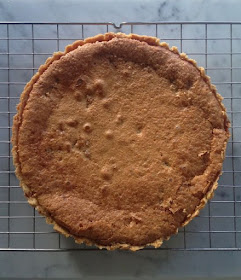 |
| Candied Citrus Peels |
Following a winter of gorging on particularly good citrus, there's a stash of candied citrus peel in the fridge. Maybe I'm a bit mean but I do like to get my money's worth out of citrus fruits. It's a frugal point I've made before - Candied citrus - but home-made is far better than anything you can get in a supermarket and way cheaper than the, admittedly, good stuff from up-market stores. Having urged you to make it, I notice I've been less than helpful on how to use these carefully preserved peels. Time to remedy that.
We're talking lemon, orange, grapefruit and cedro, sweet and bitter flavours essential to much of our cooking when you stop to think about it. Chopped peel has to be in the mix for many British fruit cakes like Christmas Cake, and Easter Simnel Cake. Ditto Tea Cakes, Fruit Tea Loaf, Hot Cross Buns, Yorkshire Fat Rascals, Cornish Saffron Cake and Wiltshire Lardy Cake (although some would disagree). Christmas Sweet Mincemeat too benefits from the tang of bitter that preserved peel brings to the party. It goes into Italian Christmas Panettone, Colomba di Pasqua, Panforte and Pangiallo. Chopped candied peel is fantastic in a Cassata ice cream or scattered along with some raisins in a Bread and Butter Pudding. A little added to a Brioche mix or a Steamed Sponge Pudding works well too. You can elevate a simple Pound Cake by either folding candied citrus, chopped, into the batter or decorating the top when cooked with thin slices. I'm sure you can think of more now we've got going.
Here's another idea for which, as so often, I'm indebted to Jane Grigson and her book English Food. 'Sweetmeat Cake' is an 18th century open tart. There is also a version of it as 'Sweet-meat Pudding' in Hannah Glasse's The Art of Cookery Made Plain and Easy (1747). I always approach these old recipes with caution. Tastes change. In this case the recipe was very simple and the ingredients list rang no alarm bells. What caught my attention was that rather than candied peel providing just a background note, here it has the starring role. There's a 19th century version of this recipe, known as 'Duke of Cambridge Pudding' which dispenses with the hazelnuts (optional in the earlier recipe) altogether and calls for 4 egg yolks (no whole eggs). Grigson implies she prefers the Sweetmeat Cake recipe and declares it her favourite of the 18th century open tarts. For her its butterscotch flavour and semi-transparent filling has a "much superior flavour" to the later 'Treacle Tart'. I get what she means, there is an almost jellied quality to the cooked filling, and a slice of this is lot lighter and less sweet than a portion of treacle tart.
 |
| Sweetmeat Cake |
Personally, I'd include the hazelnuts because I am a fan of frangipane. For this tart I made a sweet shortcrust and, because I have a horror or undercooked pastry, I baked it blind before adding the filling (the original recipe does not). I've given my pastry recipe here but Jane Grigson's recipe states simply "Puff or shortcrust pastry". I've changed her wording in the method a little to allow for giving you my pastry recipe. I've also slightly reduced the amounts of candied peel, sugar and butter in the filling from the first time I made this. Otherwise, it is just as she instructs.
 |
| Sweetmeat Cake slice |
Sweetmeat Cake
(makes a 23cm shallow tart)
PASTRY (this will make twice as much as you need, so freeze half the pastry for later):
250g (10oz) plain flour
25g (1oz) ground almonds
Pinch of salt
150g(6oz) butter
75g (3oz) icing sugar
Grated rind of half a lemon
1 egg yolk
3 tablespoons milk
FILLING:
100g (4 oz) chopped candied peel
50g (2 oz) chopped roasted hazelnuts (optional)
2 large eggs
2 large egg yolks
150g (6oz) caster sugar
150g (6 oz) lightly salted butter, melted (gently)
Sift the flour into a mixing bowl and add the ground almonds and salt. Add the butter and rub in with fingertips. Sift in icing sugar and add grated lemon rind and mix. Lightly beat the egg yolk and milk together and stir into the dry ingredients. Mix until the dough just comes together then turn out and knead gently to smooth the surface. Divide into two and freeze one for later. Cover the other half and rest in fridge for just 30 minutes.
Pre-heat the oven to 200C (fan 180C)/Gas 5.
Roll the pastry thinly and line a greased 23cm shallow flan tin with it. Prick the base several times and rest in the fridge for 15 minutes.
Line with greaseproof paper and baking beans and bake the tart base for 10 minutes. Remove the paper and beans and return to the oven for 5 minutes.
Reduce the oven to 180C (fan 160C)/Gas 4.
Scatter first the chopped peel over the tart base and then the chopped hazelnuts.
Beat the remaining ingredients together thoroughly then pour into the tart case.
Bake for 35-40 minutes, checking it after 30 minutes. The top should be crusted with a rich golden brown all over. Expect the mixture to rise above the pastry then sink back down a little after its removed from the oven. The top will crack on cooling, a bit like a brownie mixture does. Do not worry if the centre part of the filling is a little liquid beneath the crust as it makes a delicious sauce. The consistency is a matter for individual taste.
Best eaten warm (though it does keep a day), with or without cream. A very good use for some of your winter stash of candied citrus. What do you mean, you don't have a stash - Candied citrus